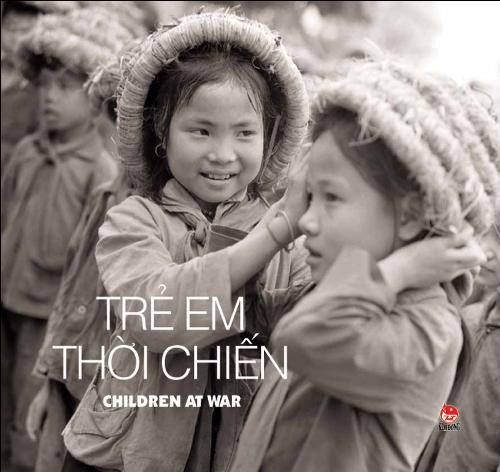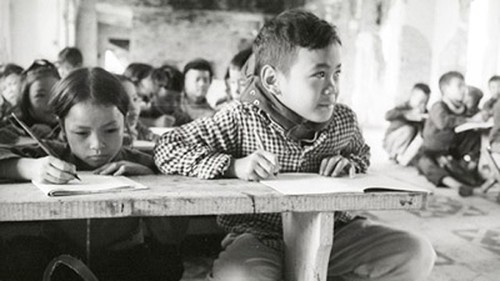(VOVworld) - There have been many movies and literary works depicting the lives of adults during war time, however, the number of works featuring the daily lives of the children during this time is limited. Many may ask themselves how Vietnamese children could survive during the hardest period of the war? Kim Dong Publishing House has brought out a pictorial book titled “Tre em thoi chien” or “Children in War Time”. The book not only shows how Vietnamese children lived through the war but also helps people to explain why the Vietnamese won such a great success in their struggle for national independence. Thi Loan reports.
 |
Nearly 100 photos, most of which are black and white, reflect the daily lives of Vietnamese children during the destructive war in the North from 1964 to 1972, the most severe period of the war against the American imperialists. But no damage, no pain or tears can be seen in the photos. In contrast, prevalent in the photos are cheerful faces, innocent eyes full of hope. Without reading the author’s notes, no one could imagine the pictures were taken during war time. The children still go to school and play with one another happily. The cover picture captures the attention of the viewer. The two girls are showing each other how to wear straw hats, which raises questions inside us: can the straw hat or the children’s innocence protect them from the enermy’s bombs? The photo was taken by Tran Minh Dao, a battlefield reporter for the Vietnam News Agency in Viet Tri city, Phu Tho province 47 years ago. Now, at the age of 76, Mr. Dao still clearly remembers the moment he took that photo: "I took this photo before I went to Vinh Linh, Quang Tri province in 1966. The anti-American war in the North had expanded to Viet Tri, Phu Tho. At that time, I had joined an air force squadron who were protecting Viet Tri bridge, and also worked as a reporter for the Vietnam News Agency. We heard warning sirens and saw US bombardments everyday. One day, I went to Minh Phuong primary school in the North of Viet Tri and saw the pupils digging trenches from their classes to the hills. Every pupil had straw hat on their heads. One girl showed her friend how to wear the hat, and I captured that moment. Later, when Viet Tri bridge was destroyed by a bomb, I was sent to the battlefield in Vinh Linh, Quang Tri province. One day, a friend of mine back in Hanoi informed me that my photo had won a special prize from the Soviet Union’s Peace Council".
During the war, straw hats were indispensable for Vietnamese children, helping to protect them from injuries caused by bomb fragements. The straw hat was so popular that every one could make it for himself. Apart from making their hats, children also had to master other skills, such as digging tunnels, making bread and first-aid in case of injuries.
At that time, poet Tran Dang Khoa was known as a child prodigy in poetry. Even at the age of 8, Khoa’s poems were being published in the newspaper. He was captured in 5 photos by journalist Vu Quang Huy, who was, at that time, working for Nhan Dan or the People’s newspaper and Thieu Nien Tien Phong, the Young Pioneers newspaper. Poet Tran Dang Khoa was so moved to see the photos again, because they reminded him of his childhood during the cruel war especially his first days at school: "That was in 1965. Although the American war had extended to the North, the Americans still mainly bombarding the Central region. So, my homeland here in the North was still experiencing peace. I still remember my first day at school. Instead of learning the poem, “My homeland is so beautiful and has the shape of sickle”, my teacher asked us to close our books. Our first lesson was about how to detect and escape from bombs. Our teacher explained to us “If the bomb looks like a marble, it is going to fall down, but if the bomb is as long as a stick, it is far away from us, so just sit still and put on your straw hat”. He showed us how to look for the shelter and run to the tunnels. Then we practiced first-aid. All the pupils were so eager and it felt funny because we had mock battles, but the teacher just sat still in the corner of the class, I saw tears falling down from his eyes. Then I realized that war was not like our mock battles, war was not a joke".
In fact, war was far from a joke. A few months later, battle broke out in the small village of Khoa. Many people died or were injured, and many houses were destroyed. However, in his poem “To my friend, Chi Le”, Khoa wrote: “ We are not afraid of American invaders, we still sing along happily”: "Even though the village was heavily bombarded with many houses being destroyed, the Vietnamese people, including the children, were not afraid. The Vietnamese are known for their strong will. In my poem, I wrote: “lotus still blossoms in our school’s pond, the crickets still playing by the bank of the pond. We still went to school, played and helped our parents with the housework. Our daily lives were truly reflected in those photos".
Why do Vietnamese have such strong will? Photo reporter Ngo Minh Dao, who witnessed many battlefields from the North to the South during the war, explained: "The war in Vietnam was quite different from others. It was a just war for national independence. The Vietnamese people, including the elderly and the young, entered the war bravely, and with great hopes of defeating the invaders. The war was so cruel. I witnessed the US bombardment of a school in Dai Phong, Le Thuy district, Quang Binh province. But in such a brutal time of war, the Vietnamese people still thought of their futures. The pictorial book also featured the lives of the Quang Tri people in the Vinh Moc underground tunnels. Many children were born in the tunnels, and there were also hospitals and schools. There were two or three days of cease fire each year, when the children were moved to the North or evacuated to other safe areas. The future of the children was paid much attention to despite the war".
 |
5-year-old Dinh Hoang Phuong was immediately interested in the picture book. The book is a gift for Phuong from his mother on the occasion of the Mid-autumn festival.
Reporter: What did you learn from the book?
Phuong: About the trench.
Reporter: What else?
Phuong: And the tunnels.
Reporter: What were the tunnels used for?
Phuong: As shelter from the bombs. When there were bombs, people had to go the tunnels and put on straw hats.
Reporter: Do you think that your life now is much better than that of children in the past?
Phuong: Yes.
Reporter: So, what should you do?
Phuong: I should be well-behaved.
Sometimes, recalling the past is not to remember the loss and wounds but to make us more appreciative about the present.